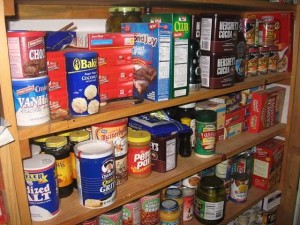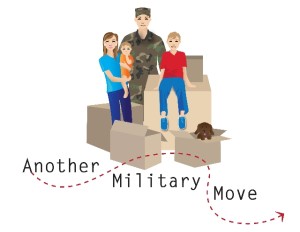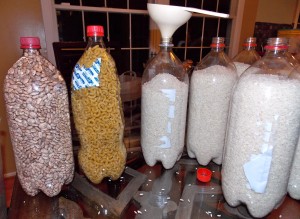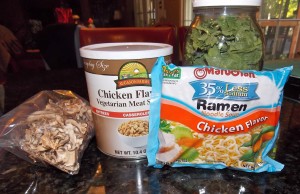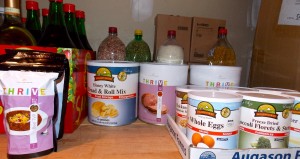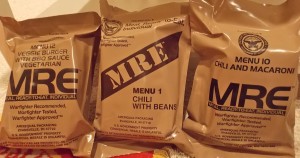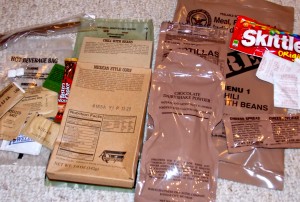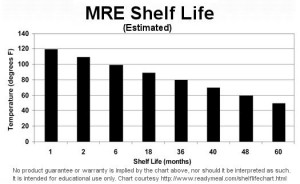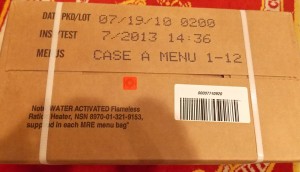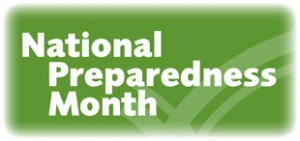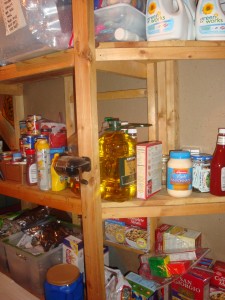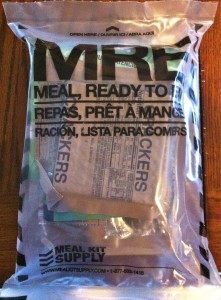 After Momma Bear’s post on MREs (meals ready to eat) we decided we wanted to add more MREs to our preps. We have a couple of cases but, with a family of six, those would go quickly. We decided that we should have one case for each person — eating two MREs a day, this would last six days.
After Momma Bear’s post on MREs (meals ready to eat) we decided we wanted to add more MREs to our preps. We have a couple of cases but, with a family of six, those would go quickly. We decided that we should have one case for each person — eating two MREs a day, this would last six days.
The ones we currently have I bought from a military surplus store. They were already a couple of years old, I have no idea what conditions (temperatures) they had been stored at, and they cost $70 a case. So I was looking for another source when, coincidentally, I was contacted by Meal Kit Supply (after they saw Momma Bear’s post), and asked if I would consider reviewing their product. I said that I would, and a few days later a case of MREs arrived in the mail.
Like Momma Bear said, MREs have improved substantially over the years. My first MRE was in USMC boot camp in February 1986, and if you were starving (and we were) they were…okay. When I went back into the National Guard in 1996, it was obvious they’d done some work to improve them — and they were better. (The last MRE I ate was in 1999.)
When we opened the case from Meal Kit Supply the first thing I noticed is that they were packaged in clear, heavy-duty, plastic bags (instead of the tan military ones). That was kind of cool.
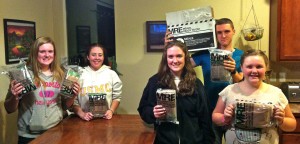 I wanted to get the whole family in on the sampling/reviewing. I wanted them to be familiar with the meals, including how to use the Flameless Ration Heater. So we randomly grabbed six out of the case (case of 12). Instead of trying to explain to them how to use the Heaters I chose to let them watch the video on the Meal Kit Supply website and then see how easy it was to follow the instructions.
I wanted to get the whole family in on the sampling/reviewing. I wanted them to be familiar with the meals, including how to use the Flameless Ration Heater. So we randomly grabbed six out of the case (case of 12). Instead of trying to explain to them how to use the Heaters I chose to let them watch the video on the Meal Kit Supply website and then see how easy it was to follow the instructions.
Then, in the kitchen, we each opened an MRE. I explained that each had an entrée, side dish, dessert, bread/cracker, spread, beverage, spoon, and condiment packet, and I had everyone identify what they got in their meals. We then, without any issues, activated our Flameless Ration Heater to heat our entrée and then set it aside (it takes about 10 minutes to warm up). We sampled, and then let everyone else try, our bread or crackers with the included peanut butter, jelly, or cheese spread. Once the meals were warm we each went around and allowed everyone else to sample our entrée and side dishes so we each tried everything.
Now I need to mention that my kids (ages 18, 15, 13, 11) aren’t that picky when it comes to eating; they know if it’s put in front of them that’s what’s for dinner and there’s no “I’m not eating this” nonsense. But, overall, Sarah and the kids liked them, and were pleased with the diversity and flavors. Personally I was very impressed with the freshness and overall quality of the food and flavors. Maybe it was the years since I’d last had one, but I remembered them being much less flavorful and more stale tasting.
Once we were done eating we discussed each of them, recorded comments, and rated them on a scale of 1 to 5 (1=terrible, 3=not bad at all, 5=pretty darn good). So of the random six we had eaten, here’s our menus (menus may vary), comments and average scores:
- Spaghetti, Potatoes Au Gratin, Carrot Pound Cake, Cracker, Cheese Spread, Grape Electrolyte Drink Powder (EDP), Cocoa Beverage Powder (CBP): “Spaghetti wasn’t bad, but noodles were kind of mushy” / “Cheesy potatoes were pretty dang good” — SCORE: 3.58
- Chicken with Noodles, Fried Rice, Vanilla Pudding, Cracker, Peanut Butter, Grape (EDP), CBP: “Not bad” / “Chicken tastes normal” / “Chicken was really good” / “Rice was flavorless and mushy” / “Vanilla pudding was pretty darn good” / “Grape beverage was very good” — SCORE: 3.67
- Vegetable Lasagna, Applesauce, Fudge Brownie, Wheat Snack Bread, Cheese Spread, Orange (EDP), CBP: “Slightly disappointed with the lasagna” / “Lasagna didn’t quite taste right” / “Need to add flavor to lasagna” / “Brownie wasn’t bad” / “Brownie was pretty tasty” — SCORE: 3.25
- Chicken with Feta, Potato Cheddar Soup, Chocolate Pudding, Cracker, Peanut Butter, Orange (EDP), CBP: “Chicken with feta was really good” / “Chicken entree was very good” / “Soup was very good, yea very good” / “Pudding was yuck” / “Pudding wasn’t great, but would be better warmed up” / “I like the juice” — SCORE: 4.08
- Pork Sausage Patty, Hash Browns with Bacon, Strawberry Toaster Pastry, Wheat Snack Bread, Peanut Butter, Orange (EDP), CBP: “Pork was too sweet” / “Pork tasted like real sausage” / “Bacon was nice in the hash browns” / “It’d be a nice breakfast.” — SCORE: 3.58
- Apple Maple Rolled Oats, Hash Browns with Bacon, Nut Raisin Mix with Chocolate Chips, Wheat Bread Snack, Blackberry Jam, Fruit Punch (EDP), CBP: “Oatmeal had good flavor” / “Mixing in the nuts and stuff in the oatmeal was a good idea” / “Oatmeal was mushy” / “It’d be an odd dinner” / “Blackberry jam was good” — SCORE: 3.33
So Chicken with Feta was the top score and the Vegetable Lasagna was the bottom. But nothing was below 3.25 which is in the “not bad at all” range. Everyone commented that there was nothing they wouldn’t eat, and with some time and creativity they’d be even better.
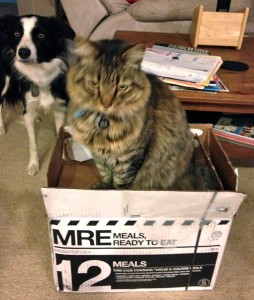
Pet Approved!
There are many sources for MREs. My only hesitation about Meal Kit Supply’s is that they are a little bit more expensive than some others, at $124.95 for a case of 12 (though that price does include shipping the 22 pound case). But their MREs are guaranteed to be fresh, they are built to military standards but use premium components. And they actually make them themselves overseeing each step of the process, they’re not just the distributors.
MREs are the perfect ‘Week 1 Food’ in a disaster: they’re pre-cooked, mobile, and ready to eat. Meal Kit Supply MREs are 100% U.S. Military food components — the same as the military uses. Now I suppose you could say that’s good or bad, but at least there is a consistent base to compare them to. I was happy with Meal Kit Supply’s service, their MRE’s taste, and was very pleased with the freshness.
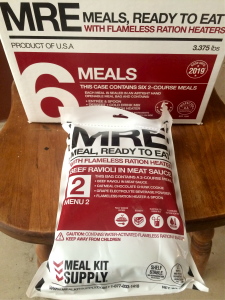 A couple years ago, I reviewed Meal Kit Supply’s MREs. Meal Kit Supply offers quality, U.S. made MREs that contain 100% military MRE components. Our family stocks them for emergencies, and I recommend them to friends.
A couple years ago, I reviewed Meal Kit Supply’s MREs. Meal Kit Supply offers quality, U.S. made MREs that contain 100% military MRE components. Our family stocks them for emergencies, and I recommend them to friends.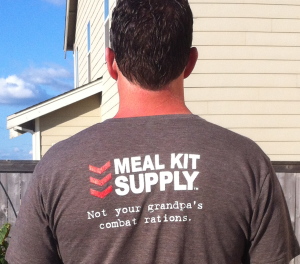 I like them. They’re a smaller, lighter meal with all the quality you’ve come to expect from Meal Kit Supply, and military grade MREs in general. Adding one (or two) to your every day carry kit adds very little weight or bulk, but a lot of piece of mind.
I like them. They’re a smaller, lighter meal with all the quality you’ve come to expect from Meal Kit Supply, and military grade MREs in general. Adding one (or two) to your every day carry kit adds very little weight or bulk, but a lot of piece of mind.



